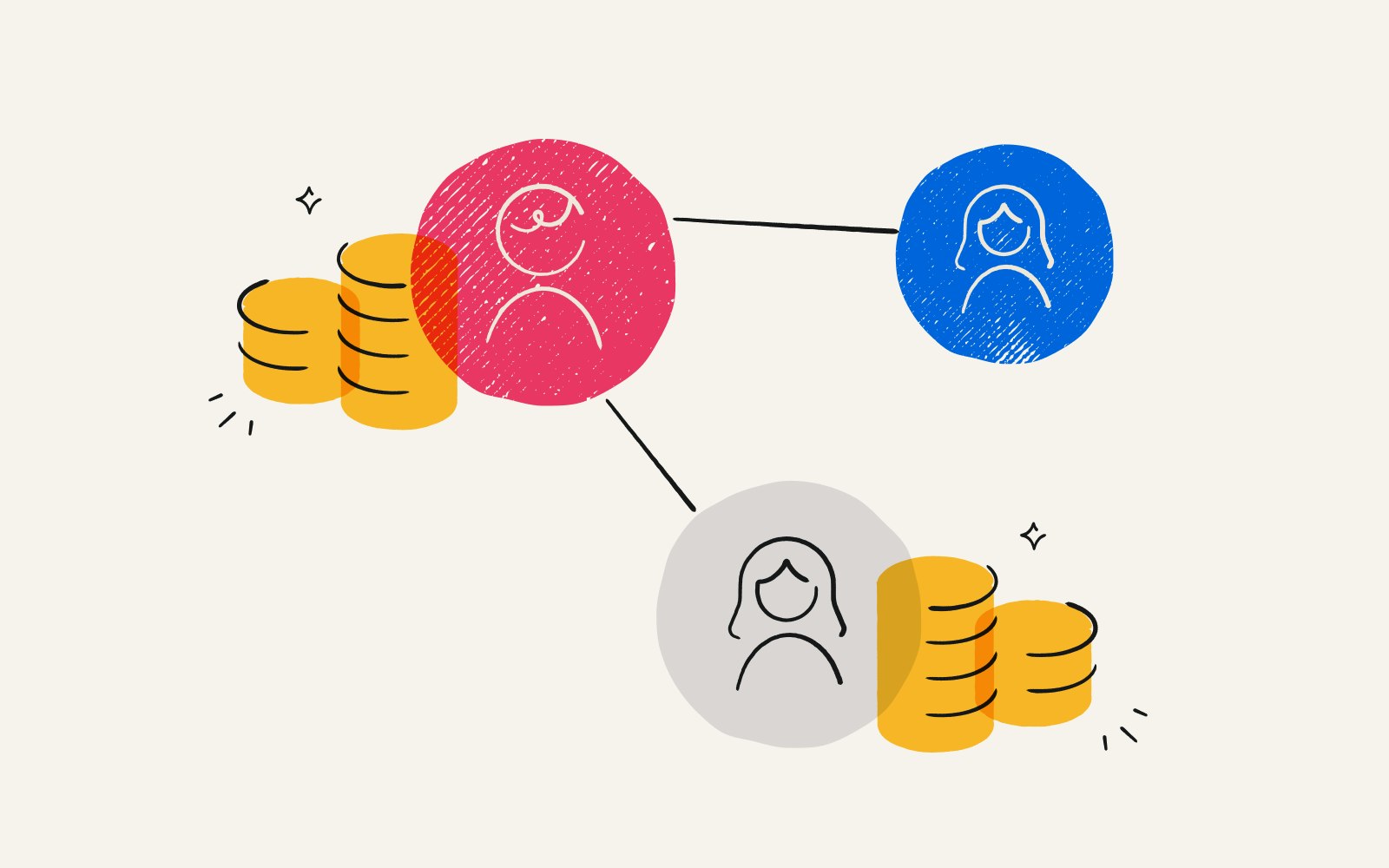Make recruiting easier with an employee referral program

People often get jobs through connections — someone they’ve worked with before, a friend of a friend, or a former colleague who put in a good word. Your own current job might have come from someone you used to work with. “It’s all about who you know,” right?
As a recruiter or hiring manager, referrals aren’t a bad thing. It’s not about hiring unqualified friends, rather it’s about tapping into a network of pre-vetted candidates. A current member of your team who you already trust is saying, “This person is smart, reliable, and great at what they do.” That’s a valuable quality filter.
So how do you turn the natural advantage of referrals into a structured, repeatable recruitment process? Enter the employee referral program.
What are employee referral programs?
An employee referral program is a structured internal system that rewards current employees for recommending qualified candidates who subsequently get hired. This type of program taps into your existing team’s networks to bring in top talent, which is an efficient way to supercharge your recruiting strategy.
Referral programs aren’t just a clever recruiting shortcut, they’re also a strategic edge. Referring employees put their own reputation on the line when they make a referral, which motivates them to be careful about who they recommend. That means you’re getting high-quality candidates who come with built-in endorsements.
“I think employee referral programs are the best way to hire by tapping into your team’s network,” explains Nicole Dennett, head of people at Modern Life. “Team members know our company culture better than anyone, so it’s way easier than me sifting through thousands of resumes.”
The role of referrals in modern recruiting strategies
Ironically, the rise of online job boards has made it harder, not easier, for job postings to stand out. Job seekers wade through an endless sea of listings, while hiring managers sift through a flood of spray-and-pray applications. AI-generated cover letters only add to the noise in your applicant tracking system.
Employee referral programs help cut through this clutter. Word-of-mouth recruiting brings the human element back to the hiring process and puts your open positions in front of the right people.
Benefits of internal referral programs
A well-run referral program isn’t just good for hiring managers, it also benefits employees and candidates.
Benefits for employees
Employees want to work with people they like and respect. They’re not going to refer someone they can’t stand or who might reflect poorly on their own reputation.
Referral bonuses give employees a solid financial incentive and make it worth their time to spread the word about job openings.
Existing employees become part of the hiring process, which gives them a sense of investment in the company’s future.
Benefits for candidates
Referred candidates get their resumes to the top of the pile, skipping the black hole of online job applications.
Employee referrals give candidates a direct connection to the company, which makes the hiring process feel more personal and less like a shot in the dark.
Existing employees supporting and rooting for their referrals can give referred candidates a confidence boost.
Benefits for hiring managers
Referrals give hiring managers access to pre-vetted, probable culture-fit candidates who have already been vouched for by employees the managers trust.
Referred candidates often move through the hiring pipeline faster than cold applicants, which results in faster hiring cycles.
Employees who get hired through referrals tend to stay longer, which helps reduce turnover costs and improves overall retention.
Challenges of internal referral programs
Referral programs are powerful, but they’re not foolproof. Here are some common pitfalls to watch out for.
Lack of diversity
If referrals come mostly from existing employees' personal circles, your candidate pool may become too homogeneous.
A lack of diversity can take many forms. Think beyond demographic diversity — if you’re only hiring from employee referrals, your employees will all be coming from similar industry backgrounds as well.
A referral program should complement other recruiting strategies, not replace them. Balance referrals with proactive sourcing to help maintain a healthy mix of experience.
Unclear incentives
A vague or inconsistent rewards structure can make employees lose interest in referring candidates. You need a well-communicated, fair incentive system to support talent acquisition.
You can mitigate challenges like a lack of diversity and unclear incentives with some proper planning. “There’s a myth that referrals hurt diversity. I disagree,” says Dennett. “You can be intentional and use training to make sure referrals actually broaden your talent pool.”
When it comes to unclear incentives, keep things simple. Dennett makes her referral system easy by having employees send her LinkedIn profiles of potential candidates they know.
“It just needs to be very simple. If you have a ton of portals and difficulty submitting to a complex system, no one’s going to bother [referring candidates].”
3 lessons from effective employee referral programs
Here are three examples of employee referral program strategies that have worked for other companies.
1. Modern Life: Turn up the fun
While Modern Life’s referral program runs year round, it’s natural for employees to forget about the referral process when they’re busy focusing on their primary priorities. That’s why Dennett set up the “sourcing jam.”
“I sent everyone beer and a Zoom link at 4 p.m. and said: Add everyone you know who’d be a fit to a shared Google Sheet. $5,000 per hire. It was great.”
2. Enterprise Rent-a-Car: Introduce competition
Enterprise Rent-a-Car taps into competitive natures with a leaderboard that tracks who’s submitted the most employee referrals. This gamified approach creates its own momentum where employees are motivated not just by the reward, but also by seeing their names climb through the ranks.
3. PricewaterhouseCoopers: Set time limits
Sometimes all you need is the oldest marketing trick in the book: Offering a special cash bonus “for a limited time only.” This method introduces a sense of urgency and puts the squeeze on employees to think of candidates before time runs out.
Accounting firm PricewaterhouseCoopers used this technique in a widely shared email seeking new employee talent from other firms.
How to create your own referral program for employees
If you want to start sourcing candidates through employee referrals, here are four basic steps you’ll need to follow to set up a program.
1. Get buy-in from leadership
The first step to launching any new program is to get stakeholder buy-in. If you just start handing out $5,000 checks to employees, it might raise some eyebrows with your finance team. But employee referral programs really sell themselves with some simple math.
“It’s an easy sell,” says Dennett. “Show the cost of filling a role with an agency, the cost of leaving it unfilled, and compare that to a $5,000 or $10,000 bonus with a huge ROI.”
Once you’ve got buy-in and budget, you’re ready to start communicating the program to your internal teams.
2. Explain the need and build urgency with internal teams
Financial motivators are great, but to really experience success, you have to communicate the why to employees. Remember, most of these employees aren’t HR people and they won’t necessarily understand the importance of filling roles quickly and with reliable candidates.
3. Establish clear guidelines
Make the program rules abundantly clear so employees know exactly when and how they can receive a bonus. What roles are eligible? What counts as a referral? Who can participate? Are managers eligible?
Part of making a program simple and effective is implementing clear and digestible rules.
4. Communicate consistently over time
Your work doesn’t stop once the referral program launches. You should maintain consistent communication about the program across teams over time.
Employees are busy and focused on their own roles, not the hiring needs of other departments. If you want referrals, you need to keep the program top of mind. That means repeating the message often and making sure everyone — from new hires to senior staff — knows what’s in it for them.
The clearer and louder the incentive, the more likely employees will spot great talent and send it your way.
Employee referral best practices
The best employee referral programs have a few things in common: simplicity, consistency, and clarity. Here are a few tips to keep your program running smoothly:
Keep the submission process dead-simple
Don’t make employees use portals or fill out 20-minute forms. Encourage your teams to send referrals through simple, straightforward channels like Slack messages. Keep the mandatory information simple as well. You can request a link to the candidate’s LinkedIn social media profile or a copy of their resume as a way to get things moving.
Close the loop
Let employees know what’s happening with their referral. Did they get an interview? A job offer? Giving your existing team members a quick status update keeps employee engagement and investment high.
"It’s important to make it really easy for employees to submit referrals,” says Dennett. “and just as important to keep them in the loop about how their candidate is progressing through the interview process," Communication should extend up to onboarding.
Time-limited boosts work
If employees have stopped submitting as many referrals, run occasional short-term incentive campaigns to reignite interest. Consider doubling referral bonuses or offering extra perks for referrals within a specific timeframe, or to fill a particularly crucial role. (Just make sure to get financial stakeholders on board first.)
Track results and adjust
Pay attention to where your best hires are coming from and which teams refer candidates most often. Use that information to refine your approach, and don't be afraid to dial up the rewards if engagement drops.
“Engagement can drop off sometimes. When that happens, I just up the bounty. If no one’s biting at $5,000, I raise it to $10,000,” says Dennett.
Key takeaways
Employee referral programs are one of the most efficient and effective ways to source top talent. Leveraging your team’s existing networks gives you access to high-quality, pre-vetted candidates ready to move through the hiring process faster and stay with your company longer.
To build your own successful employee referral program, keep it simple, transparent, and consistently top of mind — and don’t underestimate the power of an incentive.
With the right structure in place, referrals can become a reliable engine to power your hiring success.

